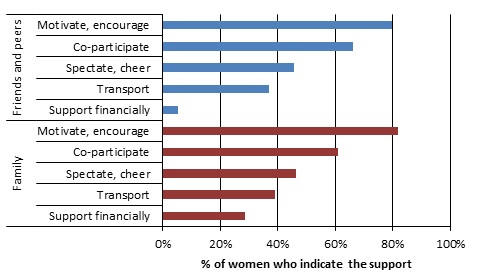2019-2021 Physical Activity Monitor (Adult Focus),

The Canadian Fitness and Lifestyle Research Institute’s (CFLRI) 2019-2020 Physical Activity Monitor asked adults (18 years and older) about sources of social support of physical activity and sport opportunities.
Family members, doctors or other health care providers, and friends and peers are the three top supportive groups identified by women for their physical activity and sport participation.
The results from this survey indicated that the majority of women agreed to a moderate or great extent that family members, doctors or other health providers, and friends and peers provided support for physical activity and/or sport. More specifically, 77% indicated family members, 67% indicated friends and peers, followed by 66% who reported that doctor or other health care providers were supportive to a moderate or great extent about their physical activity or sport. Thirty-three percent of women reported that social and faith groups, followed by 26% of women who had stated that coaches, trainers, or instructors were supportive to a moderate or great extent. Generally speaking, the percentages citing a high degree of support from all of these groups were higher among women than men (see Figure 1).
Figure 1: Percentage of adults citing sources of social support for physical activity

Source: CFLRI, aggregated results from the 2019-2021 Physical Activity Monitor
Women, aged 65 years and older, were least likely compared to younger women to have reported that family members were supportive to a moderate or great extent about their physical activity or sport (69% of women aged 65 years and older compared to 81%-84% of younger women). A similar pattern appeared for friends and peers; 59% of older women reported that friends and peers were supportive to a moderate or great extent compared to 73%-82% of younger women who have reported this. Women, 45 years and older, were less likely to have reported that social or faith groups or coaches, trainers, and instructors were supportive of their participation compared to younger women.
The overwhelming majority of women indicated that family members provide motivation or encouragement for their participation in physical activity or sport.
Participants were also asked to indicate the manner in which support was received from family members and from friends and peers. Most women in the study said that family members provided support by motivating and encouraging them (82% of women). To a lesser extent, women said family members: co-participated (61%); spectated/cheered for them (46%); transported or took them places to be active (39%); or, provided financial support (28%). Women and men were equally as likely to have reported that family members provided support through motivation or encouragement, by spectating or cheering, or co-participating. Women were, however, more likely than men to say that family members have transported or have taken them to places where they could be active, or provided financial support. Figure 2 highlights how women and men received support for physical activity and sport.
When looking at age and gender, women, aged 65 and older, were considerably less likely (45%) than women aged 25-to-64 (64%-68%) to have said that family members co-participated with them in sport and physical activity. Generally speaking, the percentage of women who have indicated that family members transported them or take them to places to be active decreased considerably with age, from 54% of 18-to-24 year old females to 32% of women aged 65 years and older. A similar pattern also exists among women who have said that their family members motivated or encouraged them, spectated and cheered, or provided financial support.
Similar questions were asked about how friends and peers supported participation in sport and physical activity, and these percentages were very similar to those of family members, already described. More specifically, among women:
- 80% reported that friends and peers provided motivation and encouragement
- 66% said that friends and peers co-participated
- 46% indicated that friends and peers spectated or cheered for them
- 37% stated that friends or peers transported them to places to be active
- 5% reported that friends and peers provided financial assistance.
There were generally no gender-related differences in the type of support provided to support participation by friends and peers with one exception, a higher percentage of women (80%) than men (72%) have reported that friends and peers provided motivation and encouragement to support physical activity and sport participation.
Among women specifically, however, there were considerable decreases by age in the percentage of women who have indicated that friends and peers co-participated in physical activity and sport, motivated or encouraged, spectated or cheered, or provided transportation.
Figure 2: Type of support for physical activity and sport

Source: CFLRI, aggregated results from the 2019-2021 Physical Activity Monitor
Three out of ten women reported that they have no family members to participate with in physical activity and sport. Over one-third (38%) of women stated that one to two family members co-participated, and 33% indicated three or more family members. There were no significant differences between women and men reporting this number of family members co-participating. Older women, aged 65 years and older, were the most likely to state that they have no family members to co-participate with in sport and physical activity, and were least likely to have reported three or more family members.
Approximately three out of ten (29%) women stated that they have no friends or peers to co-participate with, whereas 27% reported one to two friends and peers, and 44% cited three or more. A greater percentage of men reported no friends and peers, whereas a greater percentage of women cited one to two friends or peers. Women, aged 65 years and older, were the most likely to have reported that they have no friends and peers to co-participate in sport and physical activity, and were least likely to have reported three or more friends and peers.

